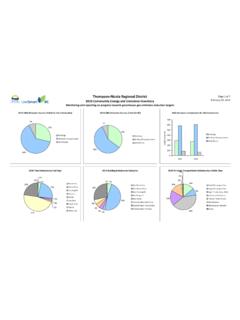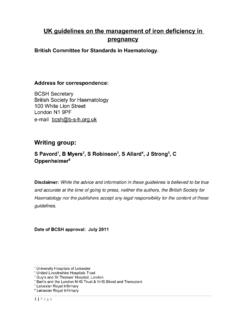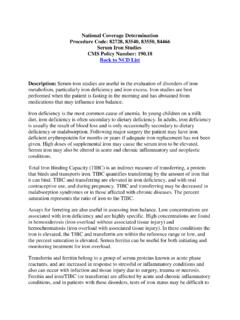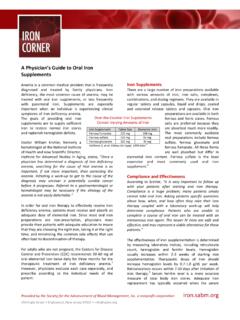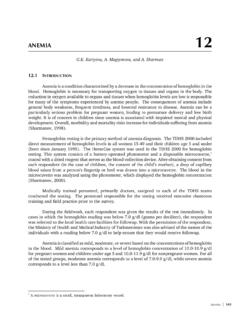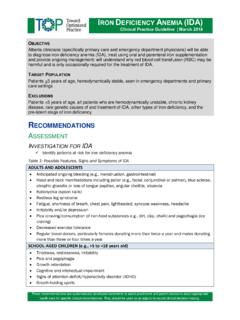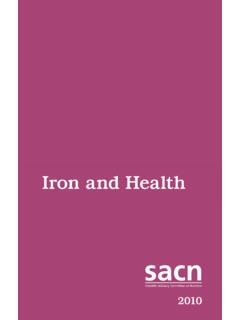Transcription of Iron Deficiency – Diagnosis and Management
1 Guidelines & Protocols Advisory CommitteeIron Deficiency Diagnosis and ManagementEffective Date: April 17, 2019 ScopeThis guideline provides recommendations for the Diagnosis , investigation and Management of iron Deficiency in patients of all ages. Key Recommendations Use a case-finding approach to identify individuals at risk of iron Deficiency and iron Deficiency anemia (Table 1). There is no indication for population-based general screening. Determine the cause of iron Deficiency . Consider age and clinical presentation when investigating for cause. iron Deficiency by itself causes symptoms for patients, even in the absence of anemia , and warrants investigation and treatment.
2 Ferritin is the test of choice for the Diagnosis of iron Deficiency . Ferritin values occur on a continuum. The suggested cut-offs are estimated ranges that should be interpreted using clinical judgment based on the patient s age, gender, risk profile (Table 1) and symptoms. Serum iron , iron binding capacity, and transferrin saturation/fraction saturation are not routinely useful for investigating iron Deficiency anemia . Take a nutrition history and provide dietary education to address dietary risk factors. Caregivers of infants and toddlers should receive guidance to prevent excessive cow s milk intake. Prescribe oral iron supplements as first line therapy for iron Deficiency .
3 One preparation is not preferred over another; patient tolerance should be the guide. anemia should correct in 2 4 months. Continue oral iron for 4 6 months after anemia corrects to replenish iron stores. Consider prescribing IV iron when there is inadequate response to oral iron , intolerance to oral iron therapy, or ongoing blood loss. DefinitionsIron Deficiency : insufficient total body iron stores, caused by increased requirements, decreased intake, increased loss, and/or decreased absorption1 (see Table 1). anemia : low hemoglobin level, most frequently defined as a hemoglobin value over two standard deviations below the gender- and age-adjusted A hemoglobin value below the local, lab-specific lower reference interval indicates Deficiency anemia (IDA): anemia due to insufficient body iron stores1.
4 The following laboratory findings are typical for IDA: microcytic anemia , hypochromia, and decreased ferritin. IDA may be normocytic if anemia is mild or in early iron : iron Deficiency Diagnosis and Management (2019)Identification of Patients at Risk for iron Deficiency and iron Deficiency AnemiaScreening of the general population for iron Deficiency is not Use a case-finding approach to identify patients at risk of iron Deficiency and iron Deficiency anemia (Table 1). Common risk profiles, by age, include: Infants and toddlers (refer to page 7) Adolescents and adults: endurance athletes, regular blood donors, disordered eating Pre-menopausal women: especially those with menorrhagia, vegetarian diet All adults age >65 All ages: low socioeconomic status, lack of balanced diet, inadequate nutritional intakeTable 1: Common causes of and risk factors for iron Deficiency and IDA in adultsNote.
5 Please refer to iron Deficiency in Children and iron Deficiency in Obstetrics on pages 7 8 for causes and risk factors in children, pregnancy and the perinatal RequirementsDecreased Intake Pregnancy (2nd/3rd trimester) Lactation Rapid growth spurts (infants, children, adolescents) Low socioeconomic status Vegetarian or vegan diet Lack of balanced diet or poor intake Eating disorder Alcohol use disorder Age > 654 Recent immigration from developing regions with lower access to iron -rich foods, higher rates of infectious disease, and higher rates of multiparity5, especially Southeast Asia, Africa6 Increased LossDecreased Absorption Menstruating girls and women (at least 10% are estimated to have iron Deficiency )
6 4 GI bleedingo Colon cancero Gastric/small bowel cancero Hemorrhoidso Peptic ulcer diseaseo Inflammatory bowel diseaseo Angiodysplasiao Esophagitis Regular blood donation Post-operative patients with significant blood loss Hematuria (gross or microscopic) Intravascular hemolysis Endurance athletes Upper GI pathology:o Chronic gastritis (incl. H pylori gastritis, atrophic gastritis/pernicious anemia )o Celiac diseaseo Crohn s diseaseo Gastric lymphoma Medications that decrease gastric acidity or bind iron , antacids/PPIs Gastrectomy or duodenal bypass Bariatric surgery Chronic renal failure3 : iron Deficiency Diagnosis and Management (2019)Signs and Symptoms in Adults Even in the absence of anemia , isolated iron Deficiency causes symptoms and warrants investigation and treatment.
7 Early stage iron Deficiency can exist without overt anemia , but with other non-hematological symptoms7 due to Deficiency of iron -containing cellular enzymes and unsaturated myoglobin. Some patients may be and symptoms of iron Deficiency and IDA in adults: Fatigue Cold intolerance Headaches Restless leg syndrome* Irritability/depression Nail changes, koilonychia (spoon nails) Angular cheilitis Pica/pagophagia (ice craving) Decreased aerobic work performance Hair loss Adverse pregnancy outcome Impaired immune functionTesting Initial investigational testsThe recommended initial tests for iron Deficiency and for IDA, in otherwise well patients, should usually be limited to serum ferritin and complete blood count (CBC).
8 Refer to page 4 for guidance on additional testing in patients with comorbid conditions. Table 2: Initial Investigational TestsInvestigationApplicationNotesSerum Ferritin Diagnostic test of choice for iron Deficiency Adults (ug/L)10, 11< 15 diagnostic of iron deficiency15-30 probable iron Deficiency >30 iron Deficiency unlikely>100 normal iron stores 600 consider test for iron overload12 Children (ug/L) < 12 diagnostic of iron deficiency12-20 possible iron deficiencyFerritin values occur on a continuum; cut-offs are suggested and clinical interpretation is required: The likelihood of iron Deficiency increases with lower ferritin concentrations, including those that overlap with the normal reference interval.
9 The normal reference interval is derived from healthy outpatients without signs of iron Deficiency or chronic illness. In adults, iron Deficiency is unlikely if ferritin >30 ug/L (or >70-100 in a patient with chronic inflammatory disease,13 or >50 in the elderly2) Ferritin is an acute phase reactant and may be unreliable in patients with chronic disease, active inflammation, or malignancy. Testing ferritin is not recommended during acute infection or hospitalization. Non-hematologic symptoms can occur when the serum ferritin is in the low normal range (< 30 ug/L)Hematology Profile (CBC) Hemoglobin value is required to assess severity of anemia May suggest iron Deficiency Not diagnostic test of choice for iron deficiencyThe following findings CBC and peripheral smear findings are highly suggestive of iron Deficiency : hypochromia (low mean corpuscular hemoglobin concentration (MCHC)) microcytosis (low mean corpuscular volume (MCV))Patients with microcytic anemia should not be given iron supplements until iron Deficiency is confirmed by testing ferritin.
10 Low MCV in the setting of normal ferritin may indicate hemoglobinopathies such as thalassemia especially in high risk ethnic groups. Long term iron therapy is harmful for these to Appendix C: Algorithm for Investigation of iron Deficiency in Non-Anemic Adults.* iron therapy may improve restless legs syndrome severity and restlessness. iron supplementation is recommended if serum ferritin is 75 , 94 : iron Deficiency Diagnosis and Management (2019) Additional tests for the Diagnosis of iron Deficiency in patients with chronic disease, inflammation or malignancyAnemia of chronic disease (ACD) may co-exist with an element of true iron Deficiency .




